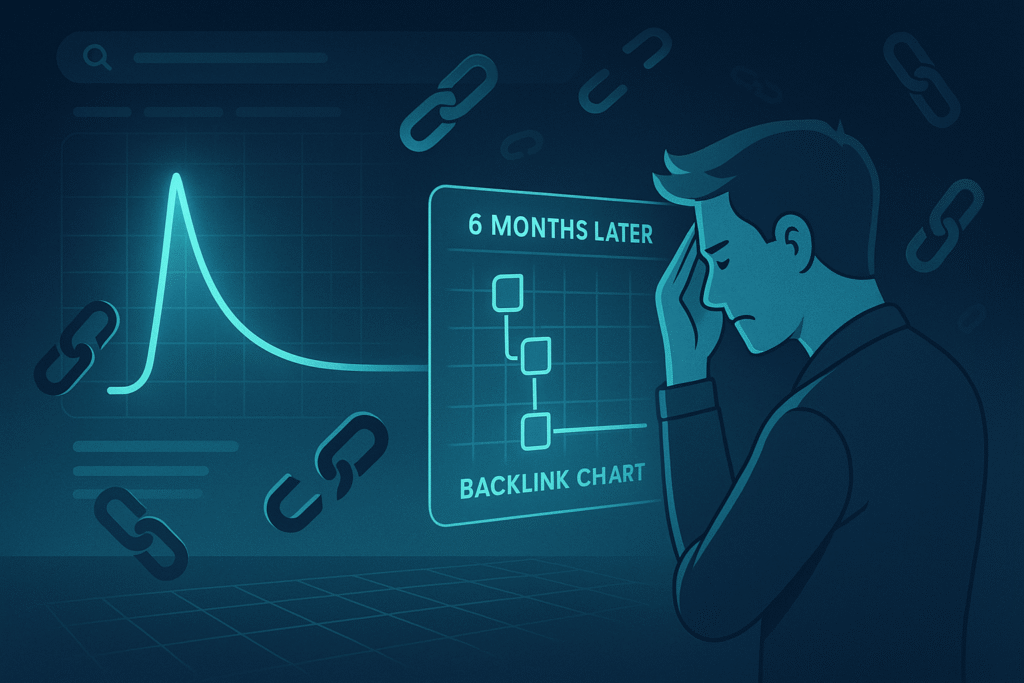Why Everything Slows Down After 6 Months
Let’s be honest—link building takes time, money, and strategy. So it’s frustrating when your campaign crushes it for a few months… and then suddenly hits a wall.
You check your rankings. They’ve plateaued. Your traffic? Not growing anymore. And your leads? Ghost town.
This isn’t bad luck. You’re likely facing link velocity decay—a common and critical mistake that can tank months of hard work.
Let’s break it down.
What Is Link Velocity and Why Should You Care?
Link velocity refers to the speed at which your website gains new backlinks over time. It’s not just how many links you get, but how consistently you get them.
Search engines like Google don’t just track your backlinks. They track how fast and how steadily they come in. A strong and regular flow of links signals that your site is relevant, growing, and valuable.
On the flip side, if your backlink growth suddenly slows or stops, it sends a very different message: “This site may no longer be worth ranking.”
What Is Link Velocity Decay?
Link velocity decay happens when your website’s rate of link acquisition starts to decline—usually after the first few months of a link building campaign.
Think of it like a rocket launch. You put all the fuel into getting off the ground. You climb fast. But then, without more fuel? You stall in mid-air and start drifting.
That’s exactly what happens to many websites after month five or six. No more new links = no more SEO momentum.
Why Do Most Campaigns Fail After Month 6?
1. The “One-and-Done” Mindset
Many marketers treat link building like a one-time push. Launch some guest posts, do some outreach, score a few directory links—and call it a day.
But that’s not how SEO works anymore. You need to build continuously. SEO rewards consistency, not short bursts.
2. No Plan Beyond the Initial Campaign
Most link campaigns are front-loaded with effort. You outreach like crazy, get those early wins, and then… forget to plan for what happens next.
Six months later, your links dry up. No new backlinks = no fresh SEO signals.
3. Content Gets Stale, Fast
People don’t link to old, outdated content—no matter how well it performed in the beginning.
If your blog post hasn’t been updated in six months, your link potential drops. Plain and simple.
4. Competitors Catch Up
Your initial campaign gave you an edge. But while you were coasting, your competitors were grinding. They’re earning links steadily. They’re staying top of mind. That momentum shift can undo all your hard work.
How Google Reacts to Link Velocity Decay
Google doesn’t just look at what you did—it looks at what you’re doing now.
If you built 100 links in 3 months, but 0 in the last 3, Google’s algorithm might assume:
- You were artificially boosting rankings
- Your content is no longer gaining interest
- Your authority isn’t growing anymore
None of those signals are good for SEO.
A steady, natural-looking link acquisition curve looks more trustworthy—and earns longer-term ranking stability.
How to Spot Link Velocity Decay Before It Hurts
Watch Your Link Trends
Use tools like Ahrefs, SEMrush, or Google Search Console. Look at your “New & Lost Backlinks” graph.
If the number of new backlinks is trending downward or flatlining, you’re in decay mode.
Look at Organic Traffic Correlation
Link velocity impacts rankings, which impacts traffic. If your backlink growth slows, and your traffic follows, you’ve likely hit the decay point.
How to Prevent Link Velocity Decay
1. Build a 12-Month Link Strategy
Stop thinking in 3-month sprints. Your SEO efforts should be mapped out like a content calendar.
Plan for:
- Seasonal outreach
- Ongoing guest posting
- Monthly link-worthy content creation
2. Create Evergreen Link Magnets
Content that earns links on autopilot? That’s your best weapon against decay.
Examples:
- Tools and calculators
- Ultimate guides
- Long-form case studies
- Industry data or reports
Evergreen content continues to attract backlinks naturally, long after you hit “publish.”
3. Keep Your Content Fresh
Schedule quarterly updates to top-performing blog posts. Refresh stats, rewrite intros, re-promote it.
When people see your content is current, they’re more likely to reference and link to it.
4. Blend Outreach and Organic Growth
Don’t rely solely on cold outreach. Focus on creating content people actually want to link to.
- Answer burning industry questions.
- Provide unique insights.
- Publish original data.
Good content + targeted promotion = natural, sustained link growth.
Consistency Compounds Over Time
Link building isn’t a campaign—it’s a habit.
Google doesn’t just reward big link spikes. It rewards steady, trustworthy growth over time.
Think of it like saving for retirement. One deposit won’t do much. But regular deposits over months and years? That builds real value.
The same goes for backlinks. Keep showing up. Keep creating. Keep earning links.
The Takeaway
Your SEO doesn’t fail because of what you did—it fails because of what you stopped doing.
Link velocity decay is real, but it’s preventable. With the right systems in place, you can maintain steady backlink growth, dominate search rankings, and avoid that painful six-month cliff.
If you want help planning a link strategy that doesn’t die after Q2, get in touch with the SEO experts at SEO Sets—we build long-term link campaigns that actually last.
FAQs
1. What’s the ideal pace for link building?
There’s no universal speed, but aim for a consistent pace. 10 links a month regularly beats 100 links in one week followed by silence.
2. Can I recover from link velocity decay?
Yes. Restart outreach, refresh your top pages, and invest in new content that attracts backlinks.
3. Is link velocity a confirmed ranking factor?
Google doesn’t confirm everything, but link acquisition rate is clearly monitored. Consistent backlink growth often correlates with steady ranking improvements.
4. Should I always be building new links?
In most cases—yes. SEO is an ongoing game. You’re either growing or falling behind.
5. What tools help monitor link velocity?
Ahrefs, SEMrush, and Google Search Console all track link acquisition over time. Monitor these regularly to stay ahead of decay.


